FNR24150 -- Week 13 Notes
Introduction to Feeding & Food Habits
- Although some exceptions exist, amphibians and reptiles mostly feed on:
- @@Frogs & salamanders: insects@@
- @@Turtles: plans & animals (vertebrates & invertebrates)@@
- @@Squamates: animals (vertebrates & invertebrates)@@
Projectile Tongues
Commonly found in amphibians (Anurans)
\
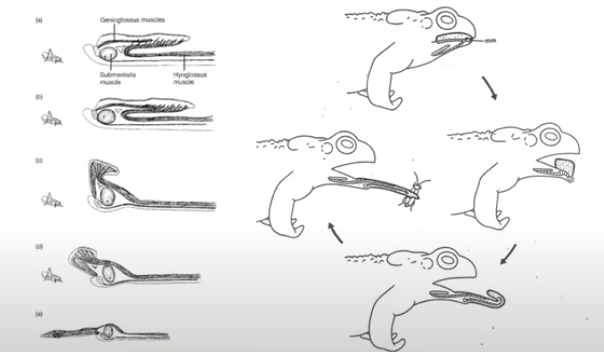
- On left:
- A: projection; mouth opening
- B: tongue flips forward
- C: tongue fully extended and turned upside down; dorsal surface of tongue tip encircles prey
- D: muscles contract and the retract tongue back inside
Plethodontidae Salamanders
\
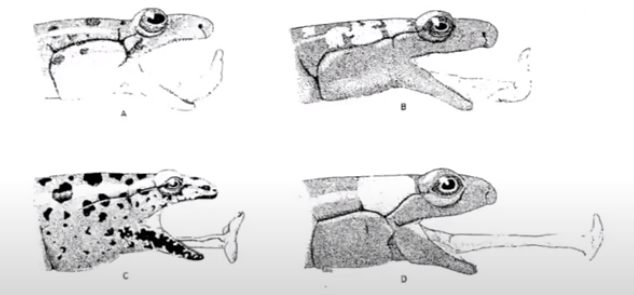
- A: minimal protrusion
- B: Modest protrusion
- C: free tongue and considerable protrusion
- D: free tongue and extreme protrusion
- In some salamander spp., length of tongue = half length of body
Squamates (Chameleons)
\

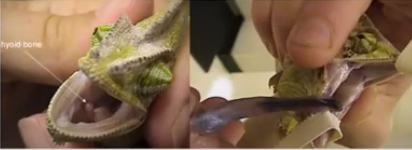
Digestive System
Digestive Glands
Oral cavity
- Amphibians: Intermaxillary gland
- Secretes a %%sticky%% compound that helps prey adhere to the tip of the tongue
- Found in both %%frogs & salamanders%%
- Reptiles: venom glands
- %%Modified salivary glands%%
- Very well-developed
- Used to %%subdue%% and %%digest%%
Opisthoglyph
\

%%Rear-fanged%% snakes (back of maxilla)
Fangs not hollow
%%Weak%% venom
Due to location of fangs, %%snake must move prey to back of mouth%% before digestion
IN: Hognose Snake
Proteroglyph elapid snakes
\
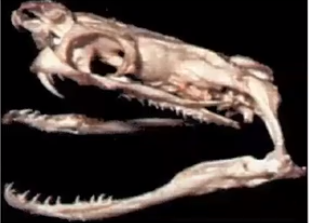
Forward-grooved snakes
%%Shortened%% maxillary bearing fangs with %%few teeth except for enlarged fangs%%
%%Fixed%% fangs with a %%hollow tube%% (like a needle/syringe)
Many species are some of the %%most toxic%% (%%neurotoxins%%)
Due to the %%shortened%% nature of its %%front teeth%%, it must %%hold on%% momentarily to inject the venom
Cobras & Brown Snakes (Australia)
Solenoglyph Viperid Snakes
- %%Most advanced venom delivery method system of any snake%%
- Each maxilla %%reduced%% to a nub supporting a %%single hollow fanged tooth%%
- Fangs can be as long as %%half the length of head%%
- Gaboon Viper: 2 in long fangs
- Folded against %%roof%% of mouth (hinged)
- Snake opens mouth %%180°%%
- %%Slightly less toxic%% than proteroglyph; a %%hemotoxin%%
Foraging Modes
Two general foraging methods
@@Sit-and-wait (ambush foraging)@@
- Very %%little%% investment in %%time & energy%% searching for prey
- %%Most%% energy spent in %%capturing & handling prey%%
- Users generally have %%very good eyesight or special organs (pits organ)%%
- Users rely on %%cryptic coloration%%
@@Active foraging (wide foraging)@@
- Predators are %%moving through the environment%% in search of prey
- Combination of %%visual & chemical cues%%
- %%Larger home range%%
- Higher %%ATR%%
Likely a %%continuum%% of foraging modes from these two extremes
\
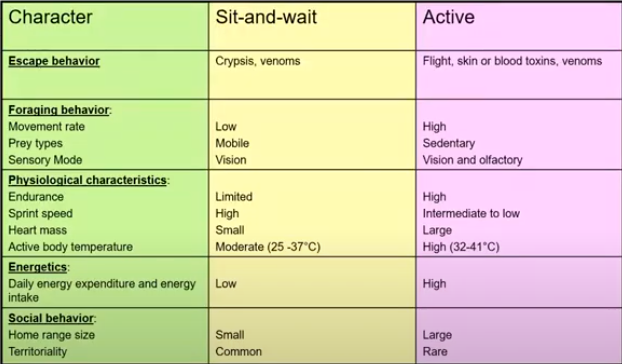
- Numerous %%ecological, behavioural, physiological, and life history%% parameters that correlate with foraging modes
Factors influencing foraging behaviour
External factors
- @@Prey availability@@
- @@Predation risk@@
- @@Societal interactions@@
- @@Habitat structure@@
Internal factors
@@How hungry is it?@@
@@Amount of learned experiences (coupled with age)@@
@@Sex and reproductive state@@
- Males may not forage since they are protecting their territory; females may forage more to produce enough eggs
@@Genetics@@
Phylogenetic factors
- @@Sensory limitations@@
- @@Morphological characteristics@@
- @@Physiological constraints@@
Prey Detection
Amphibians and reptiles can detect prey using different cues
@@Visual@@
Mostly used by %%sit-and-wait%% predators
Large, well-developed eyes
Discriminate prey based on %%shape and size%%
%%Binocular%% perception
- Can detect %%depth & distance%%
Most %%align%% heads or entire body axis with that of prey before attacking
@@Chemical@@
Olfaction
- Prey location identification by %%sniffing or rapid bugle pumping%% (frogs inflating their lower mouth)
- %%Long-distance%% detection system
- Main feeding sense of %%salamanders & lizards%%
Vomerolfaction (Jacob’s organ)
- %%Sensitive to high molecular weight compounds%%
- Transported to %%oral and nasal%% cavities by the %%snout or tongue%%
- %%Short-range%% detection system
- Main feeding sense in %%some salamanders & most snakes%%
- Snakes have %%bifurcated tongues%% (provides directionality of info)
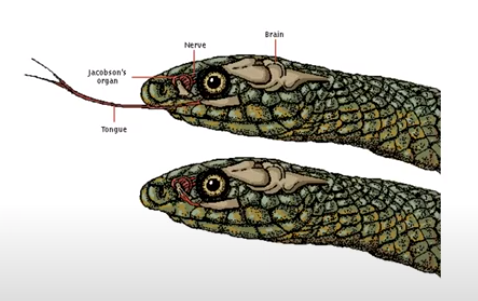
- Tongue flicks and picks up high molecular weight compounds
- Snake retracts tongue into set of grooves in upper snout in maxilla
- Forks transfer compounds into epithelial cells in Jacobson’s Organ
Taste
- Help %%distinguish%% food items from non-food items
@@Tactile@@
Relatively %%poorly understood%%
%%Mechanoreceptors%% in the skin (lateral line in aquatic amphibians)
In several spp., %%flaps of skin are highly innervated%% and also help in the tactile detection of prey
@@Thermal@@
%%Infrared light%% sensed by %%nerve endings%% in skin of head which are located %%inside pit organs%%
- Loreal pits in vipers
- Nasal/upper labial pits in pythons and boas
Pits open anteriorly (%%always face forward%%) and provide a %%binocular%%
Most effective for %%nocturnal spp.%% that feed on mammals & birds
Many spp. use some %%combination%% of these cues
Prey Capture & Ingestion
Prey Capture
- @@Biting and grasping@@
- Prey typically swallowed whole
- @@Constriction@@
- Common in boas & pythons
- @@Injected venoms@@
- Hemotoxins, neurotoxins
- @@Filter feeding@@
- Tadpoles: large buccopharyngeal cavities
- @@Suction feeding@@
- Prey is vacuumed into mouth
- @@Projectile tongues@@
Food Habits
Specific food habits depend on:
- @@Feeding adaptations of animal@@
- @@Size of animal and prey-capturing methods@@
- @@Habitat@@
- @@Relative abundance and size of prey available at time of feeding@@
Communication: Types
- Social behaviour
- An ^^interaction^^ with ^^one or more conspecifics^^ and occasionally with individuals of ^^different species^^ as well
- Communication
- ^^Transfer of information from a signaler to a receiver^^
- 4 basic types
- @@Visual@@
- Distinct colors/body movement
- @@Acoustic@@
- Vocalization/rubbing body parts together
- @@Chemical@@
- Odors
- Well-developed in salamanders, lizards, and some snakes
- @@Tactile@@
- Individual rubs/presses/hits a body part against another individual
- Advantages for communication
- %%Identify & locate mates%% in a complex environment
Communication: Salamanders
- Chemical cues
- Salamanders use %%pheromones%%
- Hormones are produced by %%courtship glands%%
- Tactical cues
- %%Mate location%% in Plethodontid salamanders aided by %%nose-tapping%%
- Also @@bite, slap, or rub@@ part of their bodies against each other
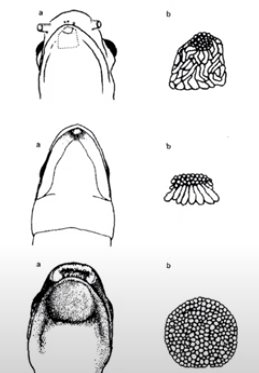
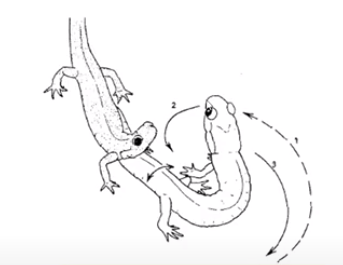
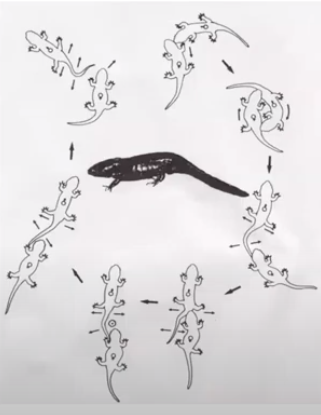
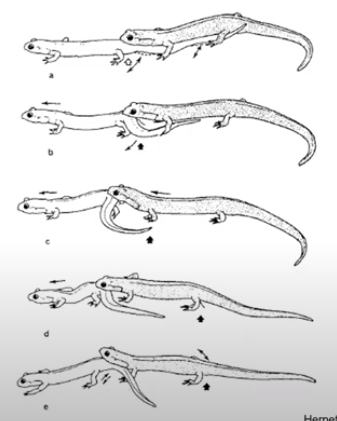
Communication: Frogs
Acoustic cues
- Very important
4 basic call categories
Advertisement
- Attract mates
- Deeper = better
Reciprocation
- Very rare
- Female calls in response to male
Release
- Males amplexing other males, so a release call is made by the one being amplexed
Distress
- Grasped by predator
Frogs can make vocalizations by passing air back and forth between lungs, vocal cords, and vocal sacs
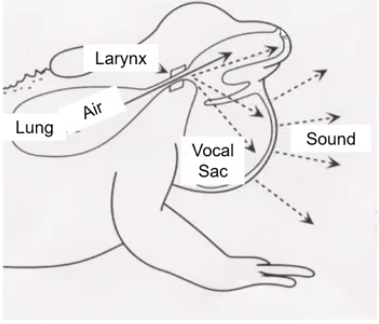
Visual cues
- %%Bright%% colorations
- Mostly in %%diurnal%% spp.
Communication: Turtles
- Visual cues
- Headbobs
- Tactile cues
- Ram, flip, trailing, biting, tickling
- Chemical cues
- Special glands on %%bridge of shells%%
- %%Cloacal secretions%% may also play a role
Communication: Lizards
- Visual cues
- Coloration of %%dewlaps,%% heads and sides of the body in males and %%bright coloration in females%%
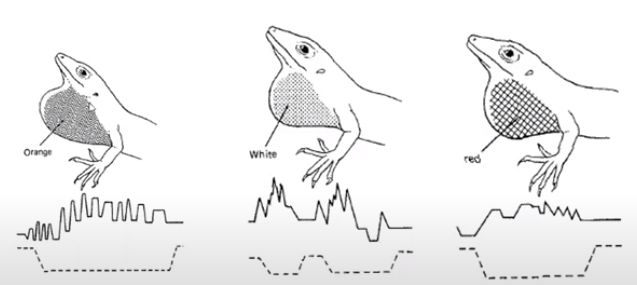
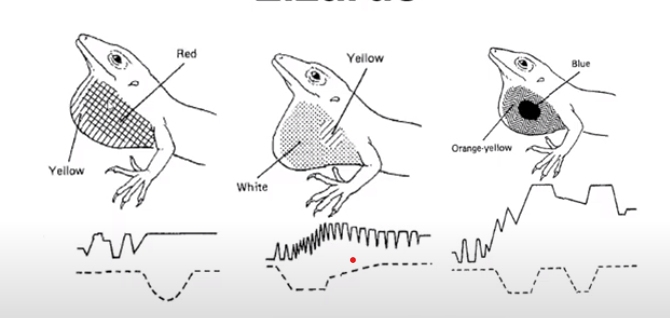

- Chemical cues
- Pheromones (skinks)
- Tactile cues
- Tongue flicking
- Neck & body scratching
Communication: Snakes
%%Tactile signals%% very important for snake courtship
3 different phases
Tactile phase
- A lot of %%chemosensory sampling of males%% to %%determine sex%% of the individual
Male %%chases%% female to copulate
Intromission & copulation
Group Behaviour: Competition
- Competition
- Interspecific
- Occasionally occurs %%among related spp%%.; frequently congregating spp. partition habitat %%temporally%% (especially during %%breeding)%%
- Different spp. in ephemeral ponds organize by spp. and by time of day
- Intraspecific
- Occasionally occurs when %%resources are limited;%% minimized in larval/juvenile forms
Group Behaviour: Cooperation
2 forms
@@Hibernation@@
- Different spp. of snakes hibernating together to reduce evaporative loss during winter
@@Breeding Aggregations@@
- Male frogs taking turns to call a female (reduces intraspecific competition)